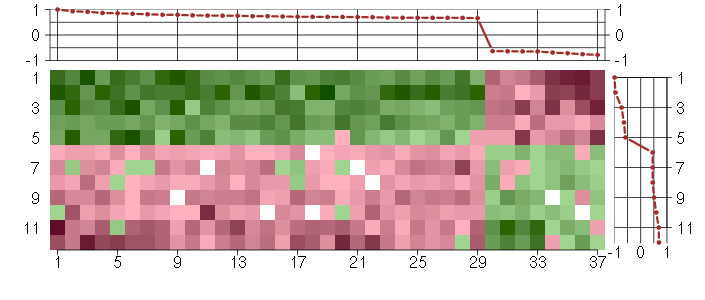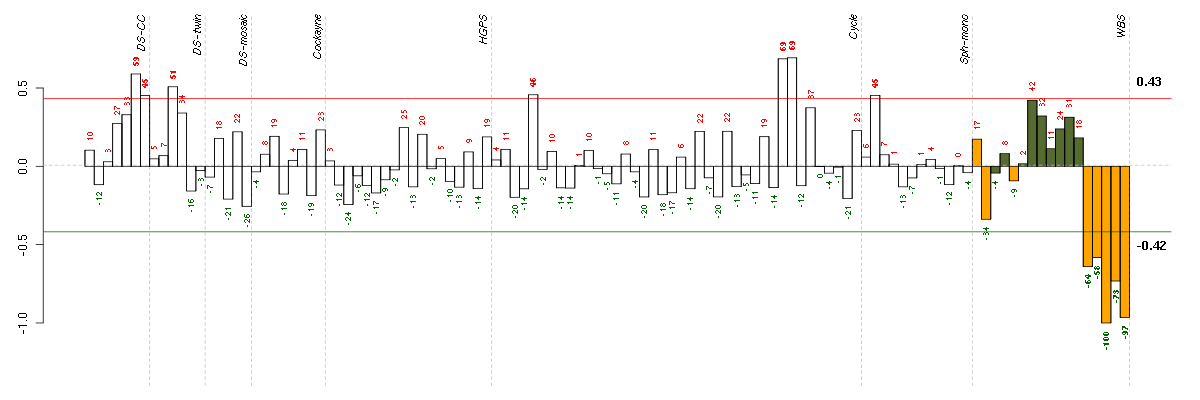



Under-expression is coded with green,
over-expression with red color.

metabolic process
The chemical reactions and pathways, including anabolism and catabolism, by which living organisms transform chemical substances. Metabolic processes typically transform small molecules, but also include macromolecular processes such as DNA repair and replication, and protein synthesis and degradation.
organic acid metabolic process
The chemical reactions and pathways involving organic acids, any acidic compound containing carbon in covalent linkage.
cellular amino acid and derivative metabolic process
The chemical reactions and pathways involving amino acids, organic acids containing one or more amino substituents, and compounds derived from amino acids, as carried out by individual cells.
amino acid metabolic process
The chemical reactions and pathways involving amino acids, organic acids containing one or more amino substituents.
nitrogen compound metabolic process
The chemical reactions and pathways involving various organic and inorganic nitrogenous compounds; includes nitrogen fixation, nitrification, denitrification, assimilatory/dissimilatory nitrate reduction and the interconversion of nitrogenous organic matter and ammonium.
biological_process
Any process specifically pertinent to the functioning of integrated living units: cells, tissues, organs, and organisms. A process is a collection of molecular events with a defined beginning and end.
amino acid biosynthetic process
The chemical reactions and pathways resulting in the formation of amino acids, organic acids containing one or more amino substituents.
biosynthetic process
The chemical reactions and pathways resulting in the formation of substances; typically the energy-requiring part of metabolism in which simpler substances are transformed into more complex ones.
cellular amine metabolic process
The chemical reactions and pathways involving any organic compound that is weakly basic in character and contains an amino or a substituted amino group, as carried out by individual cells. Amines are called primary, secondary, or tertiary according to whether one, two, or three carbon atoms are attached to the nitrogen atom.
amine biosynthetic process
The chemical reactions and pathways resulting in the formation of any organic compound that is weakly basic in character and contains an amino or a substituted amino group. Amines are called primary, secondary, or tertiary according to whether one, two, or three carbon atoms are attached to the nitrogen atom.
cellular process
Any process that is carried out at the cellular level, but not necessarily restricted to a single cell. For example, cell communication occurs among more than one cell, but occurs at the cellular level.
carboxylic acid metabolic process
The chemical reactions and pathways involving carboxylic acids, any organic acid containing one or more carboxyl (COOH) groups or anions (COO-).
cellular nitrogen compound metabolic process
The chemical reactions and pathways involving various organic and inorganic nitrogenous compounds, as carried out by individual cells.
cellular metabolic process
The chemical reactions and pathways by which individual cells transform chemical substances.
primary metabolic process
The chemical reactions and pathways involving those compounds which are formed as a part of the normal anabolic and catabolic processes. These processes take place in most, if not all, cells of the organism.
cellular biosynthetic process
The chemical reactions and pathways resulting in the formation of substances, carried out by individual cells.
nitrogen compound biosynthetic process
The chemical reactions and pathways resulting in the formation of organic and inorganic nitrogenous compounds.
all
This term is the most general term possible
cellular metabolic process
The chemical reactions and pathways by which individual cells transform chemical substances.
cellular nitrogen compound metabolic process
The chemical reactions and pathways involving various organic and inorganic nitrogenous compounds, as carried out by individual cells.
cellular biosynthetic process
The chemical reactions and pathways resulting in the formation of substances, carried out by individual cells.
cellular amino acid and derivative metabolic process
The chemical reactions and pathways involving amino acids, organic acids containing one or more amino substituents, and compounds derived from amino acids, as carried out by individual cells.
nitrogen compound biosynthetic process
The chemical reactions and pathways resulting in the formation of organic and inorganic nitrogenous compounds.
amino acid metabolic process
The chemical reactions and pathways involving amino acids, organic acids containing one or more amino substituents.
amine biosynthetic process
The chemical reactions and pathways resulting in the formation of any organic compound that is weakly basic in character and contains an amino or a substituted amino group. Amines are called primary, secondary, or tertiary according to whether one, two, or three carbon atoms are attached to the nitrogen atom.
amino acid metabolic process
The chemical reactions and pathways involving amino acids, organic acids containing one or more amino substituents.
amino acid biosynthetic process
The chemical reactions and pathways resulting in the formation of amino acids, organic acids containing one or more amino substituents.

cellular_component
The part of a cell or its extracellular environment in which a gene product is located. A gene product may be located in one or more parts of a cell and its location may be as specific as a particular macromolecular complex, that is, a stable, persistent association of macromolecules that function together.
cell
The basic structural and functional unit of all organisms. Includes the plasma membrane and any external encapsulating structures such as the cell wall and cell envelope.
cell surface
The external part of the cell wall and/or plasma membrane.
cell part
Any constituent part of a cell, the basic structural and functional unit of all organisms.
all
This term is the most general term possible
cell part
Any constituent part of a cell, the basic structural and functional unit of all organisms.

ARNTL2aryl hydrocarbon receptor nuclear translocator-like 2 (220658_s_at), score: -0.65 ASNSasparagine synthetase (205047_s_at), score: 0.68 ATF4activating transcription factor 4 (tax-responsive enhancer element B67) (200779_at), score: 0.75 C7orf58chromosome 7 open reading frame 58 (220032_at), score: -0.72 C9orf127chromosome 9 open reading frame 127 (207839_s_at), score: -0.78 CBScystathionine-beta-synthase (212816_s_at), score: 0.66 CEBPGCCAAT/enhancer binding protein (C/EBP), gamma (204203_at), score: 0.76 CHAC1ChaC, cation transport regulator homolog 1 (E. coli) (219270_at), score: 0.71 CSTAcystatin A (stefin A) (204971_at), score: 0.7 DAPK1death-associated protein kinase 1 (203139_at), score: 0.71 DDIT3DNA-damage-inducible transcript 3 (209383_at), score: 1 DDIT4DNA-damage-inducible transcript 4 (202887_s_at), score: 0.79 EGFL6EGF-like-domain, multiple 6 (219454_at), score: 0.85 ENPP1ectonucleotide pyrophosphatase/phosphodiesterase 1 (205066_s_at), score: -0.63 FAM129Afamily with sequence similarity 129, member A (217966_s_at), score: 0.74 FGF9fibroblast growth factor 9 (glia-activating factor) (206404_at), score: 0.83 FLGfilaggrin (215704_at), score: 0.76 FMODfibromodulin (202709_at), score: 0.72 GDF15growth differentiation factor 15 (221577_x_at), score: 0.81 GOLSYNGolgi-localized protein (218692_at), score: 0.93 GOT1glutamic-oxaloacetic transaminase 1, soluble (aspartate aminotransferase 1) (208813_at), score: 0.68 HSPA5heat shock 70kDa protein 5 (glucose-regulated protein, 78kDa) (211936_at), score: 0.67 IL27RAinterleukin 27 receptor, alpha (205926_at), score: -0.75 KCTD15potassium channel tetramerisation domain containing 15 (218553_s_at), score: 0.73 MTHFD2methylenetetrahydrofolate dehydrogenase (NADP+ dependent) 2, methenyltetrahydrofolate cyclohydrolase (201761_at), score: 0.68 NME3non-metastatic cells 3, protein expressed in (204862_s_at), score: -0.69 NRCAMneuronal cell adhesion molecule (204105_s_at), score: 0.79 PALMparalemmin (203859_s_at), score: 0.7 PCK2phosphoenolpyruvate carboxykinase 2 (mitochondrial) (202847_at), score: 0.71 PGPEP1pyroglutamyl-peptidase I (219891_at), score: 0.77 PSAT1phosphoserine aminotransferase 1 (220892_s_at), score: 0.68 SLC3A2solute carrier family 3 (activators of dibasic and neutral amino acid transport), member 2 (200924_s_at), score: 0.74 SLC6A9solute carrier family 6 (neurotransmitter transporter, glycine), member 9 (207043_s_at), score: 0.91 TJP2tight junction protein 2 (zona occludens 2) (202085_at), score: -0.64 TM4SF1transmembrane 4 L six family member 1 (209386_at), score: -0.64 TRIB3tribbles homolog 3 (Drosophila) (218145_at), score: 0.86 XPOTexportin, tRNA (nuclear export receptor for tRNAs) (212160_at), score: 0.67
| Id | sample | Experiment | ExpName | Array | Syndrome | Cell.line |
|---|---|---|---|---|---|---|
| F223_WBS.CEL | 15 | 8 | WBS | hgu133plus2 | WBS | WBS 1 |
| H652_WBS.CEL | 17 | 8 | WBS | hgu133plus2 | WBS | WBS 1 |
| F348_WBS.CEL | 16 | 8 | WBS | hgu133plus2 | WBS | WBS 1 |
| D890_WBS.CEL | 13 | 8 | WBS | hgu133plus2 | WBS | WBS 1 |
| F055_WBS.CEL | 14 | 8 | WBS | hgu133plus2 | WBS | WBS 1 |
| t21d 08-03.CEL | 7 | 1 | DS-CC | hgu133a | Down | DS-CC 7 |
| E-GEOD-4219-raw-cel-1311956138.cel | 4 | 7 | Sph-mono | hgu133plus2 | none | Sph-mon 1 |
| E-TABM-263-raw-cel-1515485731.cel | 5 | 6 | Cycle | hgu133a2 | none | Cycle 1 |
| 3Twin.CEL | 3 | 2 | DS-twin | hgu133plus2 | Down | DS-twin 3 |
| t21c 08-03.CEL | 6 | 1 | DS-CC | hgu133a | Down | DS-CC 6 |
| E-TABM-263-raw-cel-1515486271.cel | 32 | 6 | Cycle | hgu133a2 | none | Cycle 1 |
| E-TABM-263-raw-cel-1515486291.cel | 33 | 6 | Cycle | hgu133a2 | none | Cycle 1 |
